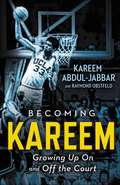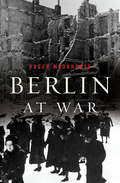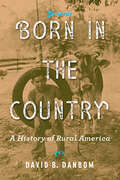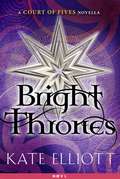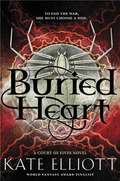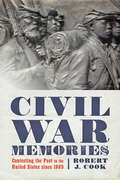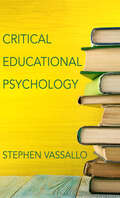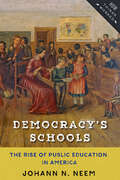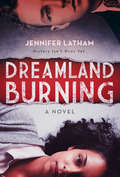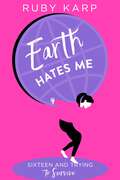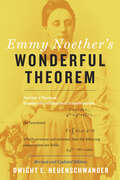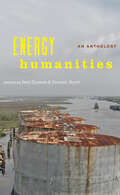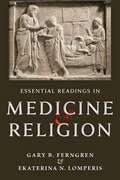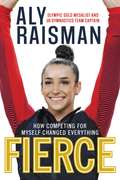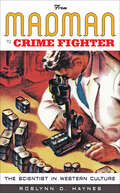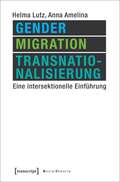- Table View
- List View
Becoming Kareem: Growing Up On and Off the Court
by Raymond Obstfeld Kareem Abdul-JabbarA NEW YORK TIMES BESTSELLER! The first memoir for young readers by sports legend Kareem Abdul-Jabbar.At one time, Lew Alcindor was just another kid from New York City with all the usual problems: He struggled with fitting in, with pleasing a strict father, and with overcoming shyness that made him feel socially awkward. But with a talent for basketball, and an unmatched team of supporters, Lew Alcindor was able to transform and to become Kareem Abdul-Jabbar.From a childhood made difficult by racism and prejudice to a record-smashing career on the basketball court as an adult, Kareem Abdul-Jabbar's life was packed with "coaches" who taught him right from wrong and led him on the path to greatness. His parents, coaches Jack Donahue and John Wooden, Muhammad Ali, Bruce Lee, and many others played important roles in Abdul-Jabbar's life and sparked him to become an activist for social change and advancement. The inspiration from those around him, and his drive to find his own path in life, are highlighted in this personal and awe-inspiring journey.Written especially for young readers, Becoming Kareem chronicles how Kareem Abdul-Jabbar become the icon and legend he is today, both on and off the court.
Berlin at War: Life And Death In Hitler's Capital, 1939-45
by Roger MoorhouseThe gripping story of civilian life in Berlin during World War II -- these "complex, often deeply morally compromised personal stories of many survivors [produce] new insights into the way ordinary Berliners tried to escape the disastrous ill-fortune of living in the belly of the beast" (Financial Times).In Berlin at War, acclaimed historian Roger Moorhouse provides a magnificent and detailed portrait of everyday life at the epicenter of the Third Reich. Berlin was the stage upon which the rise and fall of the Third Reich was most visibly played out. It was the backdrop for the most lavish Nazi ceremonies, the site of Albert Speer's grandiose plans for a new "world metropolis," and the scene of the final climactic battle to defeat Nazism. Berlin was the place where Hitler's empire ultimately meet its end, but it suffered mightily through the war as well; not only was the city subjected to the full wrath of the Soviet ground offensive and siege in 1945, but it also found itself a prime target for the air war, attracting more raids, more aircraft, and more tonnage than any other German city. Combining groundbreaking research with a gripping narrative, Moorhouse brings all of the complexity and chaos of wartime Berlin to life. Berlin at War is the incredible story of the city-and people-that saw the whole of this epic conflict, from start to finish.
Born in the Country: A History of Rural America (Revisiting Rural America)
by David B. DanbomThroughout most of its history, America has been a rural nation, largely made up of farmers. David B. Danbom's Born in the Country was the first;¢;‚¬;€?and still is the only;¢;‚¬;€?general history of rural America. Ranging from pre-Columbian times to the enormous changes of the twentieth century, the book masterfully integrates agricultural, technological, and economic themes with new questions about the American experience.Danbom employs the stories of particular farm families to illustrate the experiences of rural people. This substantially revised and updated third edition ;€¢ expands and deepens its coverage of the late twentieth and early twenty-first centuries;€¢ focuses on the changes in agriculture and rural life in the progressive and New Deal eras as well as the massive shifts that have taken place since 1945;€¢ adds new information about African American and Native American agricultural experiences;€¢ discusses the decline of agriculture as a productive enterprise and its impact on farm families and communities;€¢ explores rural culture, gender issues, agriculture, and the environment;€¢ traces the relationship among farmers, agribusiness, and consumersIn a new and provocative concluding chapter, Danbom reflects on increasing consumer disenchantment with and resistance to modern agriculture as well as the transformation of rural America into a place where farmers are a shrinking minority. Ultimately, he asks whether a distinctive style of rural life exists any longer.
Born in the Country: A History of Rural America (Revisiting Rural America)
by David B. DanbomThroughout most of its history, America has been a rural nation, largely made up of farmers. David B. Danbom's Born in the Country was the first;¢;‚¬;€?and still is the only;¢;‚¬;€?general history of rural America. Ranging from pre-Columbian times to the enormous changes of the twentieth century, the book masterfully integrates agricultural, technological, and economic themes with new questions about the American experience.Danbom employs the stories of particular farm families to illustrate the experiences of rural people. This substantially revised and updated third edition ;€¢ expands and deepens its coverage of the late twentieth and early twenty-first centuries;€¢ focuses on the changes in agriculture and rural life in the progressive and New Deal eras as well as the massive shifts that have taken place since 1945;€¢ adds new information about African American and Native American agricultural experiences;€¢ discusses the decline of agriculture as a productive enterprise and its impact on farm families and communities;€¢ explores rural culture, gender issues, agriculture, and the environment;€¢ traces the relationship among farmers, agribusiness, and consumersIn a new and provocative concluding chapter, Danbom reflects on increasing consumer disenchantment with and resistance to modern agriculture as well as the transformation of rural America into a place where farmers are a shrinking minority. Ultimately, he asks whether a distinctive style of rural life exists any longer.
Bright Thrones: A Court of Fives Novella (Court of Fives)
by Kate ElliottFrom World Fantasy Award finalist Kate Elliott comes a thrilling companion novella that links Poisoned Blade and Buried Heart, the final two books in the enthralling Court of Fives series. Bettany has always been an outsider in her family: the angry one, the wild one, the daughter who refused to accept the dominance of her Patron father's people over her Commoner mother. When her family is torn apart by a vengeful lord, Bettany makes a dangerous choice to accompany their household servants being transported to the mines, hoping she can keep them from suffering a fate worse than death. Their only chance lies with a stuffy foreign doctor who may be able to help them escape, but can Bettany trust him? Her instincts tell her there is much more to this man than meets the eye. Read the untold story of what happened to Jessamy's missing twin sister in this beautifully written companion novella to the New York Times bestselling Court of Fives!
Buried Heart (Court of Fives #3)
by Kate ElliottThe heart-pounding finale to World Fantasy Award finalist Kate Elliott's captivating, New York Times bestselling young adult series--now available in paperback!Choose between your parents.Choose between your friends.Choose between your lovers.Choose who you are.On the run from the murderous King Nikonos, Jessamy must find a way for her beloved Kalliarkos to take his rightful place on the throne. Only then can he end the oppression of the Commoners by their long time Patron overlords. But Kal's rise to power is fraught with manipulation and shocking decisions that make Jes question everything they promised each other. As their relationship frays and Jes's family and friends beg her for help, will she cast Kal and her Patron heritage aside? Will she finally join--even lead--the rebellion that had been burning among the Commoners for years?This explosive finale of World Fantasy Award finalist Kate Elliott's Court of Five series forces Jessamy to confront an inescapable truth: with or without her, the revolution has begun.
Civil War Memories: Contesting the Past in the United States since 1865
by Robert J. CookAt a cost of at least 800,000 lives, the Civil War preserved the Union, aborted the breakaway Confederacy, and liberated a race of slaves. Civil War Memories is the first comprehensive account of how and why Americans have selectively remembered, and forgotten, this watershed conflict since its conclusion in 1865. Drawing on an array of textual and visual sources as well as a wide range of modern scholarship on Civil War memory, Robert J. Cook charts the construction of four dominant narratives by the ordinary men and women, as well as the statesmen and generals, who lived through the struggle and its tumultuous aftermath. Part One explains why the Yankee victors;€™ memory of the "War of the Rebellion" drove political conflict into the 1890s, then waned with the passing of the soldiers who had saved the republic. It also touches on the leading role southern white women played in the development of the racially segregated South;€™s "Lost Cause"; explores why, by the beginning of the twentieth century, the majority of Americans had embraced a powerful reconciliatory memory of the Civil War; and details the failed efforts to connect an emancipationist reading of the conflict to the fading cause of civil rights.Part Two demonstrates the Civil War;€™s capacity to thrill twentieth-century Americans in movies such as The Birth of a Nation and Gone with the Wind. It also reveals the war;€™s vital connection to the black freedom struggle in the modern era. Finally, Cook argues that the massacre of African American parishioners in Charleston in June 2015 highlighted the continuing relevance of the Civil War by triggering intense nationwide controversy over the place of Confederate symbols in the United States. Written in vigorous prose for a wide audience and designed to inform popular debate on the relevance of the Civil War to the racial politics of modern America, Civil War Memories is required reading for informed Americans today.
Civil War Memories: Contesting the Past in the United States since 1865
by Robert J. CookAt a cost of at least 800,000 lives, the Civil War preserved the Union, aborted the breakaway Confederacy, and liberated a race of slaves. Civil War Memories is the first comprehensive account of how and why Americans have selectively remembered, and forgotten, this watershed conflict since its conclusion in 1865. Drawing on an array of textual and visual sources as well as a wide range of modern scholarship on Civil War memory, Robert J. Cook charts the construction of four dominant narratives by the ordinary men and women, as well as the statesmen and generals, who lived through the struggle and its tumultuous aftermath. Part One explains why the Yankee victors;€™ memory of the "War of the Rebellion" drove political conflict into the 1890s, then waned with the passing of the soldiers who had saved the republic. It also touches on the leading role southern white women played in the development of the racially segregated South;€™s "Lost Cause"; explores why, by the beginning of the twentieth century, the majority of Americans had embraced a powerful reconciliatory memory of the Civil War; and details the failed efforts to connect an emancipationist reading of the conflict to the fading cause of civil rights.Part Two demonstrates the Civil War;€™s capacity to thrill twentieth-century Americans in movies such as The Birth of a Nation and Gone with the Wind. It also reveals the war;€™s vital connection to the black freedom struggle in the modern era. Finally, Cook argues that the massacre of African American parishioners in Charleston in June 2015 highlighted the continuing relevance of the Civil War by triggering intense nationwide controversy over the place of Confederate symbols in the United States. Written in vigorous prose for a wide audience and designed to inform popular debate on the relevance of the Civil War to the racial politics of modern America, Civil War Memories is required reading for informed Americans today.
Critical Educational Psychology: An Examination Of Foundational Features Of The Field (Educational Psychology Ser. #15)
by Stephen VassalloThe field of critical studies recognizes that all knowledge is deeply embedded in ideological, cultural, political, and historical contexts. Although this approach is commonly applied in other subfields of psychology, educational psychology;¢;‚¬;€?which is the study of human learning, thinking, and behavior in formal and informal educational contexts;¢;‚¬;€?has resisted a comprehensive critical appraisal. In Critical Educational Psychology, Stephen Vassallo seeks to correct this deficit by demonstrating how the psychology of learning is neither neutral nor value-free but rather bound by a host of contextual issues and assumptions. Vassallo invites teachers and teacher educators, educational researchers, and educational psychologists to think broadly about the implications that their use of psychology has on the teaching and learning process. He applies a wide variety of interdisciplinary approaches to examine the psychology of learning, cognitive development, motivation, creativity, discipline, and attention. Drawing on multiple perspectives within psychology and critical theory, he reveals that contemporary educational psychology is entangled in and underpinned by specific political, ideological, historical, and cultural contexts.A valuable resource for anyone who relies on psychology to interact with, assess, and deliberate over others, especially school-aged children, Critical Educational Psychology resists neatly packaged theories, models, and perspectives that are intended to bring some basis and certainty to pedagogical decision-making. This book will enhance teachers;€™ ethical decision-making and start important new conversations about power and opportunity.
Critical Educational Psychology
by Stephen VassalloThe field of critical studies recognizes that all knowledge is deeply embedded in ideological, cultural, political, and historical contexts. Although this approach is commonly applied in other subfields of psychology, educational psychology;¢;‚¬;€?which is the study of human learning, thinking, and behavior in formal and informal educational contexts;¢;‚¬;€?has resisted a comprehensive critical appraisal. In Critical Educational Psychology, Stephen Vassallo seeks to correct this deficit by demonstrating how the psychology of learning is neither neutral nor value-free but rather bound by a host of contextual issues and assumptions. Vassallo invites teachers and teacher educators, educational researchers, and educational psychologists to think broadly about the implications that their use of psychology has on the teaching and learning process. He applies a wide variety of interdisciplinary approaches to examine the psychology of learning, cognitive development, motivation, creativity, discipline, and attention. Drawing on multiple perspectives within psychology and critical theory, he reveals that contemporary educational psychology is entangled in and underpinned by specific political, ideological, historical, and cultural contexts.A valuable resource for anyone who relies on psychology to interact with, assess, and deliberate over others, especially school-aged children, Critical Educational Psychology resists neatly packaged theories, models, and perspectives that are intended to bring some basis and certainty to pedagogical decision-making. This book will enhance teachers;€™ ethical decision-making and start important new conversations about power and opportunity.
Democracy's Schools: The Rise of Public Education in America (How Things Worked)
by Johann N. NeemAt a time when Americans are debating the future of public education, Johann N. Neem tells the inspiring story of how and why Americans built a robust public school system in the decades between the Revolution and the Civil War. It;€™s a story in which ordinary people in towns across the country worked together to form districts and build schoolhouses and reformers sought to expand tax support and give every child a liberal education. By the time of the Civil War, most northern states had made common schools free, and many southern states were heading in the same direction. Americans made schooling a public good.Yet back then, like today, Americans disagreed over the kind of education needed, who should pay for it, and how schools should be governed. Neem explores the history and meaning of these disagreements. As Americans debated, teachers and students went about the daily work of teaching and learning. Neem takes us into the classrooms of yore so that we may experience public schools from the perspective of the people whose daily lives were most affected by them.Ultimately, Neem concludes, public schools encouraged a diverse people to see themselves as one nation. By studying the origins of America;€™s public schools, Neem urges us to focus on the defining features of democratic education: promoting equality, nurturing human beings, preparing citizens, and fostering civic solidarity.
Democracy's Schools: The Rise of Public Education in America (How Things Worked)
by Johann N. NeemAt a time when Americans are debating the future of public education, Johann N. Neem tells the inspiring story of how and why Americans built a robust public school system in the decades between the Revolution and the Civil War. It;€™s a story in which ordinary people in towns across the country worked together to form districts and build schoolhouses and reformers sought to expand tax support and give every child a liberal education. By the time of the Civil War, most northern states had made common schools free, and many southern states were heading in the same direction. Americans made schooling a public good.Yet back then, like today, Americans disagreed over the kind of education needed, who should pay for it, and how schools should be governed. Neem explores the history and meaning of these disagreements. As Americans debated, teachers and students went about the daily work of teaching and learning. Neem takes us into the classrooms of yore so that we may experience public schools from the perspective of the people whose daily lives were most affected by them.Ultimately, Neem concludes, public schools encouraged a diverse people to see themselves as one nation. By studying the origins of America;€™s public schools, Neem urges us to focus on the defining features of democratic education: promoting equality, nurturing human beings, preparing citizens, and fostering civic solidarity.
Dreamland Burning
by Jennifer LathamA compelling dual-narrated tale from Jennifer Latham that questions how far we've come with race relations.Some bodies won't stay buried.Some stories need to be told. When seventeen-year-old Rowan Chase finds a skeleton on her family's property, she has no idea that investigating the brutal century-old murder will lead to a summer of painful discoveries about the present and the past.Nearly one hundred years earlier, a misguided violent encounter propels seventeen-year-old Will Tillman into a racial firestorm. In a country rife with violence against blacks and a hometown segregated by Jim Crow, Will must make hard choices on a painful journey towards self discovery and face his inner demons in order to do what's right the night Tulsa burns.Through intricately interwoven alternating perspectives, Jennifer Latham's lightning-paced page-turner brings the Tulsa race riot of 1921 to blazing life and raises important questions about the complex state of US race relations--both yesterday and today.
Earth Hates Me: True Confessions from a Teenage Girl
by Ruby Karp"This book is filled with juicy young person wisdom." --Amy Poehler The definitive guide to being a teen in the modern age, with sage advice from a modern teenager and appealing to fans of Rookie.Earth Hates Me presents a look inside the mind of the modern teenager--from a modern teenager's perspective. Sixteen-year-old Ruby Karp addresses the issues facing every highschooler, from grades to peer pressure to Snapchat stories, and unpacks their complicated effects on the teen psyche. Ruby advises her peers on the importance of feminism ("not just the Spice Girls version"), how to deal with jealousy and friend break-ups, family life, and much more. The book takes an in-depth look at the effect of social media on modern teens and the growing pressures of choosing the right college and career. Amy Poehler says, "This book is filled with juicy young person wisdom." With Ruby's powerful underlying message "we are more than just a bunch of dumb teenagers obsessed with our phones," Earth Hates Me is the definitive guide to being a teen in the modern age.
Earth Hates Me: True Confessions from a Teenage Girl
by Ruby Karp"This book is filled with juicy young person wisdom." --Amy Poehler The definitive guide to being a teen in the modern age, with sage advice from a modern teenager and appealing to fans of Rookie. Earth Hates Me presents a look inside the mind of the modern teenager--from a modern teenager's perspective. Sixteen-year-old Ruby Karp addresses the issues facing every highschooler, from grades to peer pressure to Snapchat stories, and unpacks their complicated effects on the teen psyche. Ruby advises her peers on the importance of feminism ("not just the Spice Girls version"), how to deal with jealousy and friend break-ups, family life, and much more. The book takes an in-depth look at the effect of social media on modern teens and the growing pressures of choosing the right college and career. Amy Poehler says, "This book is filled with juicy young person wisdom." With Ruby's powerful underlying message "we are more than just a bunch of dumb teenagers obsessed with our phones," Earth Hates Me is the definitive guide to being a teen in the modern age.
Emmy Noether's Wonderful Theorem
by Dwight E. Neuenschwander"In the judgment of the most competent living mathematicians, Fräulein Noether was the most significant creative mathematical genius thus far produced since the higher education of women began."â€�Albert EinsteinThe year was 1915, and the young mathematician Emmy Noether had just settled into Göttingen University when Albert Einstein visited to lecture on his nearly finished general theory of relativity. Two leading mathematicians of the day, David Hilbert and Felix Klein, dug into the new theory with gusto, but had difficulty reconciling it with what was known about the conservation of energy. Knowing of her expertise in invariance theory, they requested Noether’s help. To solve the problem, she developed a novel theorem, applicable across all of physics, which relates conservation laws to continuous symmetriesâ€�one of the most important pieces of mathematical reasoning ever developed.Noether’s "first" and "second" theorem was published in 1918. The first theorem relates symmetries under global spacetime transformations to the conservation of energy and momentum, and symmetry under global gauge transformations to charge conservation. In continuum mechanics and field theories, these conservation laws are expressed as equations of continuity. The second theorem, an extension of the first, allows transformations with local gauge invariance, and the equations of continuity acquire the covariant derivative characteristic of coupled matter-field systems. General relativity, it turns out, exhibits local gauge invariance. Noether’s theorem also laid the foundation for later generations to apply local gauge invariance to theories of elementary particle interactions. In Dwight E. Neuenschwander’s new edition of Emmy Noether’s Wonderful Theorem, readers will encounter an updated explanation of Noether’s "first" theorem. The discussion of local gauge invariance has been expanded into a detailed presentation of the motivation, proof, and applications of the "second" theorem, including Noether’s resolution of concerns about general relativity. Other refinements in the new edition include an enlarged biography of Emmy Noether’s life and work, parallels drawn between the present approach and Noether’s original 1918 paper, and a summary of the logic behind Noether’s theorem.
Emmy Noether's Wonderful Theorem
by Dwight E. Neuenschwander"In the judgment of the most competent living mathematicians, Fräulein Noether was the most significant creative mathematical genius thus far produced since the higher education of women began."â€�Albert EinsteinThe year was 1915, and the young mathematician Emmy Noether had just settled into Göttingen University when Albert Einstein visited to lecture on his nearly finished general theory of relativity. Two leading mathematicians of the day, David Hilbert and Felix Klein, dug into the new theory with gusto, but had difficulty reconciling it with what was known about the conservation of energy. Knowing of her expertise in invariance theory, they requested Noether’s help. To solve the problem, she developed a novel theorem, applicable across all of physics, which relates conservation laws to continuous symmetriesâ€�one of the most important pieces of mathematical reasoning ever developed.Noether’s "first" and "second" theorem was published in 1918. The first theorem relates symmetries under global spacetime transformations to the conservation of energy and momentum, and symmetry under global gauge transformations to charge conservation. In continuum mechanics and field theories, these conservation laws are expressed as equations of continuity. The second theorem, an extension of the first, allows transformations with local gauge invariance, and the equations of continuity acquire the covariant derivative characteristic of coupled matter-field systems. General relativity, it turns out, exhibits local gauge invariance. Noether’s theorem also laid the foundation for later generations to apply local gauge invariance to theories of elementary particle interactions. In Dwight E. Neuenschwander’s new edition of Emmy Noether’s Wonderful Theorem, readers will encounter an updated explanation of Noether’s "first" theorem. The discussion of local gauge invariance has been expanded into a detailed presentation of the motivation, proof, and applications of the "second" theorem, including Noether’s resolution of concerns about general relativity. Other refinements in the new edition include an enlarged biography of Emmy Noether’s life and work, parallels drawn between the present approach and Noether’s original 1918 paper, and a summary of the logic behind Noether’s theorem.
Energy Humanities: An Anthology
by Imre Szeman Dominic BoyerEnergy humanities is a field of scholarship that, like medical and digital humanities before it, aims to overcome traditional boundaries between the disciplines and between academic and applied research. Responding to growing public concern about anthropogenic climate change and the unsustainability of the fuels we use to power our modern society, energy humanists highlight the essential contribution that humanistic insights and methods can make to areas of analysis once thought best left to the natural sciences.In this groundbreaking anthology, Imre Szeman and Dominic Boyer have brought together a carefully curated selection of the best and most influential work in energy humanities. Arguing that today;€™s energy and environmental dilemmas are fundamentally problems of ethics, habits, imagination, values, institutions, belief, and power;¢;‚¬;€?all traditional areas of expertise of the humanities and humanistic social sciences;¢;‚¬;€?the essays and other pieces featured here demonstrate the scale and complexity of the issues the world faces. Their authors offer compelling possibilities for finding our way beyond our current energy dependencies toward a sustainable future.Contributors include: Margaret Atwood, Paolo Bacigalupi, Lesley Battler, Ursula Biemann, Dominic Boyer, Italo Calvino, Warren Cariou, Dipesh Chakrabarty, Una Chaudhuri, Claire Colebrook, Stephen Collis, Erik M. Conway, Amy De;€™Ath, Adam Dickinson, Fritz Ertl, Pope Francis, Amitav Ghosh, G;¶k;§e G;¼nel, Gabrielle Hecht, Cymene Howe, Dale Jamieson, Julia Kasdorf, Oliver Kellhammer, Stephanie LeMenager, Barry Lord, Graeme Macdonald, Joseph;‚ Masco, John McGrath, Martin McQuillan, Timothy Mitchell, Timothy Morton, Jean-Fran;§ois Mouhot, Abdul Rahman Munif, Judy Natal, Reza Negarestani, Pablo Neruda, David Nye, Naomi Oreskes, Andrew Pendakis, Karen Pinkus, Ken Saro-Wiwa, Hermann Scheer, Roy Scranton, Allan Stoekl, Imre Szeman, Laura Watts, Michael Watts, Jennifer Wenzel, Sheena Wilson, Patricia Yaeger, and Marina Zurkow
Energy Humanities: An Anthology
by Imre Szeman Dominic BoyerEnergy humanities is a field of scholarship that, like medical and digital humanities before it, aims to overcome traditional boundaries between the disciplines and between academic and applied research. Responding to growing public concern about anthropogenic climate change and the unsustainability of the fuels we use to power our modern society, energy humanists highlight the essential contribution that humanistic insights and methods can make to areas of analysis once thought best left to the natural sciences.In this groundbreaking anthology, Imre Szeman and Dominic Boyer have brought together a carefully curated selection of the best and most influential work in energy humanities. Arguing that today;€™s energy and environmental dilemmas are fundamentally problems of ethics, habits, imagination, values, institutions, belief, and power;¢;‚¬;€?all traditional areas of expertise of the humanities and humanistic social sciences;¢;‚¬;€?the essays and other pieces featured here demonstrate the scale and complexity of the issues the world faces. Their authors offer compelling possibilities for finding our way beyond our current energy dependencies toward a sustainable future.Contributors include: Margaret Atwood, Paolo Bacigalupi, Lesley Battler, Ursula Biemann, Dominic Boyer, Italo Calvino, Warren Cariou, Dipesh Chakrabarty, Una Chaudhuri, Claire Colebrook, Stephen Collis, Erik M. Conway, Amy De;€™Ath, Adam Dickinson, Fritz Ertl, Pope Francis, Amitav Ghosh, G;¶k;§e G;¼nel, Gabrielle Hecht, Cymene Howe, Dale Jamieson, Julia Kasdorf, Oliver Kellhammer, Stephanie LeMenager, Barry Lord, Graeme Macdonald, Joseph;‚ Masco, John McGrath, Martin McQuillan, Timothy Mitchell, Timothy Morton, Jean-Fran;§ois Mouhot, Abdul Rahman Munif, Judy Natal, Reza Negarestani, Pablo Neruda, David Nye, Naomi Oreskes, Andrew Pendakis, Karen Pinkus, Ken Saro-Wiwa, Hermann Scheer, Roy Scranton, Allan Stoekl, Imre Szeman, Laura Watts, Michael Watts, Jennifer Wenzel, Sheena Wilson, Patricia Yaeger, and Marina Zurkow
Essential Readings in Medicine and Religion
by Gary B. Ferngren Ekaterina N. LomperisGary B. Ferngren and Ekaterina N. Lomperis have gathered a rich collection of annotated primary sources that illustrate the intersection of medicine and religion. Intended as a companion volume to Ferngren;€™s classic Medicine and Religion, which traces the history of the relationship of medicine to religion in the Western world from the earliest ancient Near Eastern societies to the twenty-first century, this useful and extensive sourcebook places each key document in historical context.Drawing from more than 160 texts, the book explores a number of themes, including concepts of health, the causes and cure of disease, medical ethics, theodicy, beneficence, religious healing, consolation, and death and dying. Each chapter begins with an introduction that furnishes a basic historical setting for the period covered. Modern translations, some of which have been made especially for this volume, are used whenever possible. The texts are numbered sequentially within each chapter and preceded by a short introduction to both the author and the subject.Touching on Mesopotamia, Egypt, Israel, Greece, Rome, the European Middle Ages, Islam, early modern Europe, and the modern era, Essential Readings in Medicine and Religion brings a wide range of sources together to expand on the crucial lessons of Medicine and Religion. This book is a useful introduction for all students of history, divinity, medicine, and health.
Essential Readings in Medicine and Religion
by Gary B. Ferngren Ekaterina N. LomperisGary B. Ferngren and Ekaterina N. Lomperis have gathered a rich collection of annotated primary sources that illustrate the intersection of medicine and religion. Intended as a companion volume to Ferngren;€™s classic Medicine and Religion, which traces the history of the relationship of medicine to religion in the Western world from the earliest ancient Near Eastern societies to the twenty-first century, this useful and extensive sourcebook places each key document in historical context.Drawing from more than 160 texts, the book explores a number of themes, including concepts of health, the causes and cure of disease, medical ethics, theodicy, beneficence, religious healing, consolation, and death and dying. Each chapter begins with an introduction that furnishes a basic historical setting for the period covered. Modern translations, some of which have been made especially for this volume, are used whenever possible. The texts are numbered sequentially within each chapter and preceded by a short introduction to both the author and the subject.Touching on Mesopotamia, Egypt, Israel, Greece, Rome, the European Middle Ages, Islam, early modern Europe, and the modern era, Essential Readings in Medicine and Religion brings a wide range of sources together to expand on the crucial lessons of Medicine and Religion. This book is a useful introduction for all students of history, divinity, medicine, and health.
Fierce: How Competing for Myself Changed Everything
by Aly RaismanThe New York Times bestseller!Discover Aly Raisman's inspiring story of dedication, perseverance, and learning to think positive even in the toughest times on her path to gold medal success in two Olympic Games--and beyond. Aly Raisman first stepped onto a gymnastics mat as a toddler in a "mommy & me" gymnastics class. No one could have predicted then that sixteen years later, she'd be standing on an Olympic podium, having achieved her dreams. Aly's road to success was full of hard work, perseverance, and victories, but not without its hardships. Aly faced many obstacles, from naysayers who said she'd never make it in gymnastics to classmates who shamed her for her athletic body to a devastating betrayal of trust. Through it all, Aly surrounded herself with supportive family, friends, and teammates and found the inner strength to remain positive and believe in herself. Now, in her own words, Aly shows what it takes to be a champion on and off the floor, and takes readers on a behind-the-scenes journey before, during, and after her remarkable achievements in two Olympic Games--through her highest highs, lowest lows, and all the moments in between. Honest and heartfelt, frank and funny, Aly's story is enhanced with never-before-published photos, excerpts from the personal journals she's kept since childhood that chronicle memorable moments with her teammates, and hard-won advice for readers striving to rise above challenges, learn to love themselves, and make their own dreams come true.
From Madman to Crime Fighter: The Scientist in Western Culture
by Roslynn D. HaynesThey were mad, of course. Or evil. Or godless, amoral, arrogant, impersonal, and inhuman. At best, they were well intentioned but blind to the dangers of forces they barely controlled. They were Faust and Frankenstein, Jekyll and Moreau, Caligari and Strangelove;¢;‚¬;€?the scientists of film and fiction, cultural archetypes that reflected ancient fears of tampering with the unknown or unleashing the little-understood powers of nature.In From Madman to Crime Fighter, Roslynn D. Haynes analyzes stereotypical characters;¢;‚¬;€?including the mad scientist, the cold-blooded pursuer of knowledge, the intrepid pathbreaker, and the bumbling fool;¢;‚¬;€?that, from medieval times to the present day, have been used to depict the scientist in Western literature and film. She also describes more realistically drawn scientists, characters who are conscious of their public responsibility to expose dangers from pollution and climate change yet fearful of being accused of lacking evidence.Drawing on examples from Britain, America, Germany, France, Russia, and elsewhere, Haynes explores the persistent folklore of mad doctors of science and its relation to popular fears of a depersonalized, male-dominated, and socially irresponsible pursuit of knowledge for its own sake. She concludes that today;€™s public response to science and scientists;¢;‚¬;€?much of it negative;¢;‚¬;€?is best understood by recognizing the importance of such cultural archetypes and their significance as myth. From Madman to Crime Fighter is the most comprehensive study of the image of the scientist in Western literature and film.
From Madman to Crime Fighter: The Scientist in Western Culture
by Roslynn D. HaynesThey were mad, of course. Or evil. Or godless, amoral, arrogant, impersonal, and inhuman. At best, they were well intentioned but blind to the dangers of forces they barely controlled. They were Faust and Frankenstein, Jekyll and Moreau, Caligari and Strangelove;¢;‚¬;€?the scientists of film and fiction, cultural archetypes that reflected ancient fears of tampering with the unknown or unleashing the little-understood powers of nature.In From Madman to Crime Fighter, Roslynn D. Haynes analyzes stereotypical characters;¢;‚¬;€?including the mad scientist, the cold-blooded pursuer of knowledge, the intrepid pathbreaker, and the bumbling fool;¢;‚¬;€?that, from medieval times to the present day, have been used to depict the scientist in Western literature and film. She also describes more realistically drawn scientists, characters who are conscious of their public responsibility to expose dangers from pollution and climate change yet fearful of being accused of lacking evidence.Drawing on examples from Britain, America, Germany, France, Russia, and elsewhere, Haynes explores the persistent folklore of mad doctors of science and its relation to popular fears of a depersonalized, male-dominated, and socially irresponsible pursuit of knowledge for its own sake. She concludes that today;€™s public response to science and scientists;¢;‚¬;€?much of it negative;¢;‚¬;€?is best understood by recognizing the importance of such cultural archetypes and their significance as myth. From Madman to Crime Fighter is the most comprehensive study of the image of the scientist in Western literature and film.
Gender, Migration, Transnationalisierung: Eine intersektionelle Einführung (Sozialtheorie)
by Helma Lutz Anna AmelinaDiese sozialwissenschaftliche Einführung nähert sich den Themen Geschlecht und Migration aus einer intersektionellen Perspektive, die die Verknüpfung von Geschlechterverhältnissen und Migrationsprozessen in den Vordergrund stellt. In systematischer und didaktisch aufbereiteter Form stellen Helma Lutz und Anna Amelina aktuelle gendersoziologische, intersektionelle und transnationale Theorien vor und verdeutlichen sie am Beispiel der Forschungsfelder transnationale Familien, Care-Arbeit und (Staats-)Bürgerschaft. Das Buch richtet sich an Studierende und Lehrende sozialwissenschaftlicher BA- und MA-Studiengänge im Bereich Gender Studies, Migration, Diversität, Transnationalität und soziale Ungleichheit. Zu jedem Kapitel werden Spiel- und Dokumentarfilme vorgestellt, die der Visualisierung von Themen- und Forschungsfeldern dienen - ergänzt durch Übungsfragen, die sowohl das Selbststudium als auch Seminardiskussionen ermöglichen.
